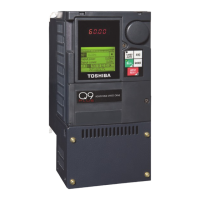Alarms, Trips, and Troubleshooting
Q9 Plus ASD Install/Op Manual
https://www.toshiba.com/tic/ 271
Viewing Trip Information
When a trip occurs, the resultant error information
may be viewed either from the LED screen, LCD
Fault screen, Monitor screen, or the Trip History
screen (Program Utilities Trip History).
Trip Record at Monitor Screen
An active trip is displayed at the Monitor screen.
Once cleared, NERR is displayed to indicate that
there are No Errors.
Note: The event that caused the trip(s) must be corrected or must decrease to less than the
threshold value required to cause the trip to allow for a Reset to be recognized. In the event
of multiple active trips, the trip displayed will remain until all faults are corrected and
cleared.
OH2
Option
Over-Heat
Over temperature error at
PTC1 or PTC2 (see F637
and F638).
• Over temperature condition detected by option
board.
OL1 ASD Overload ASD overload.
• Acceleration time is too short.
• DC Injection current is too high.
• V/f setting needs to be adjusted.
• Motor is running during restart.
• ASD/motor is improperly matched to the
application.
OP1
Over-Voltage
Acc
Over-voltage during
acceleration.
• Motor is running during restart.
OP2
Over-Voltage
Dec
Over-voltage during
deceleration.
• Deceleration time is too short.
• Stall prevention is disabled.
• 3-phase input voltage is out of specification.
• Input reactance is required.
OP3
Over-Voltage
Run
Over-voltage during fixed
speed operation.
• Load fluctuations.
• 3-phase input voltage out of specification.
OT Over-Torque Over-torque.
• Output torque requirement in excess of the F616
or F617 settings for a time longer than the F618
setting.
SOUT Step-Out (PM)
Step-out (for PM motors
only).
• Contact TIC Customer Support Center.
UC Low-Current Low-current operation. • Improper low-current detection level setting.
Table 18. Fault Codes (Continued)
LED
Screen
LCD
Screen
Fault Description Possible Cause
Note: An improper Q9 Plus ASD setup
may cause some trips — reset the
ASD to the Factory Default settings
from the following location before
pursuing a systemic malfunction
(Program
Utilities
Type Reset
Reset to Factory Settings).

